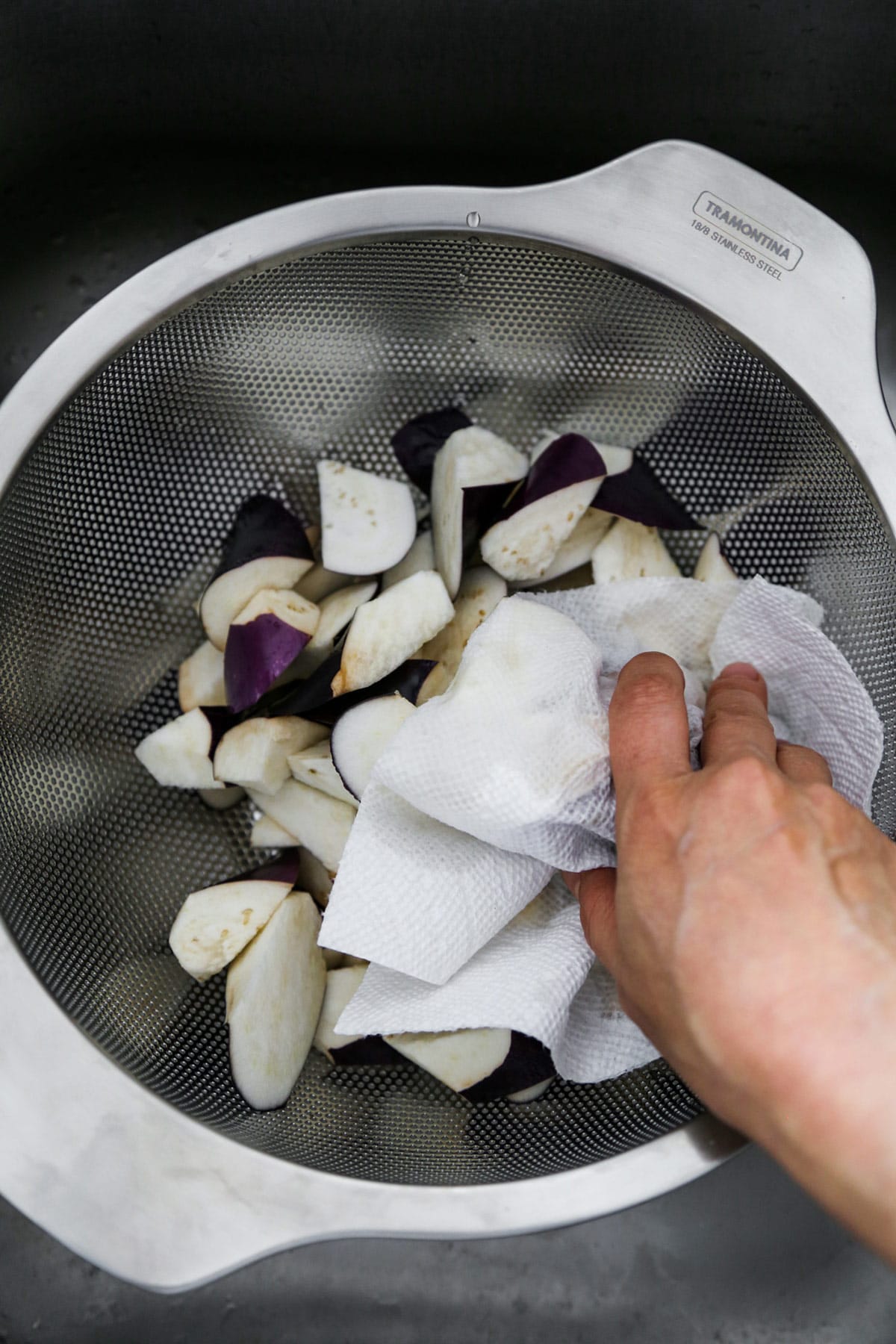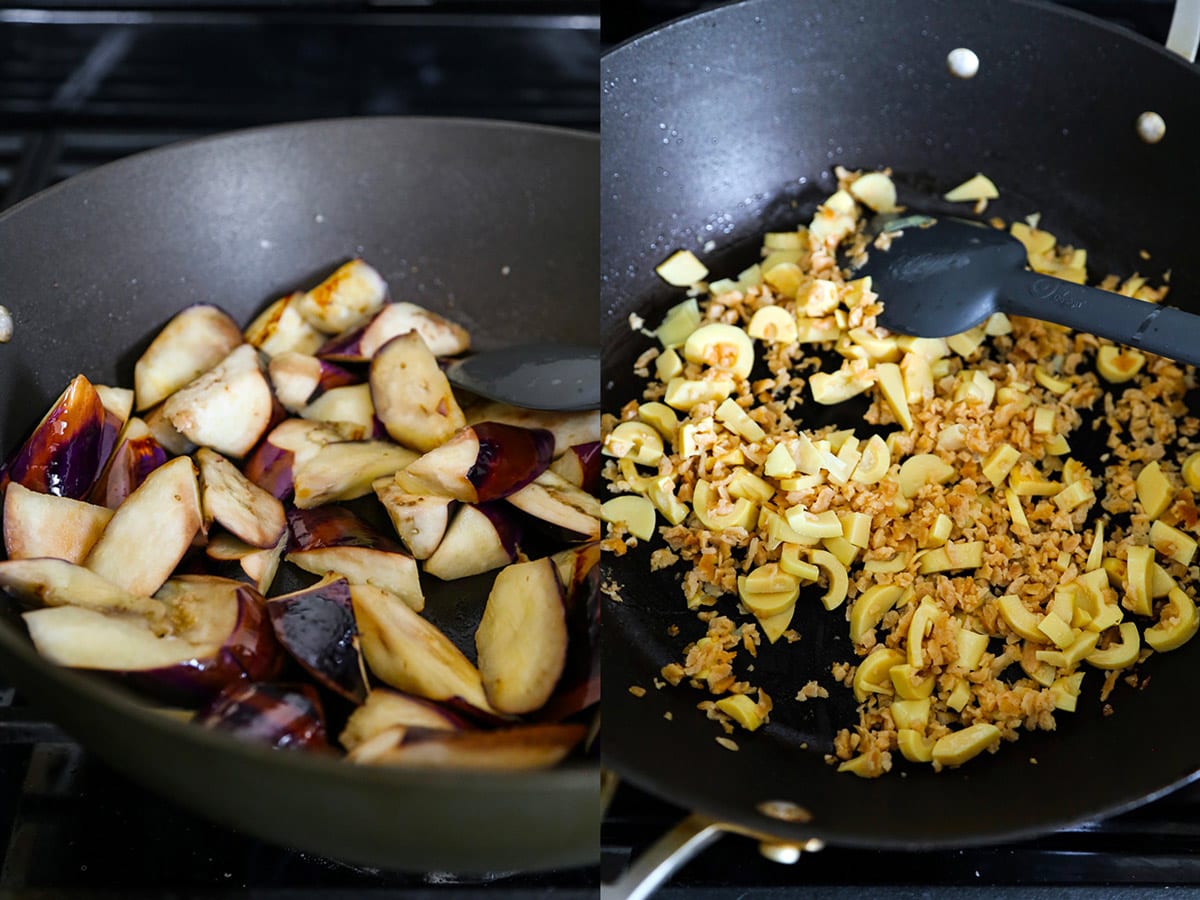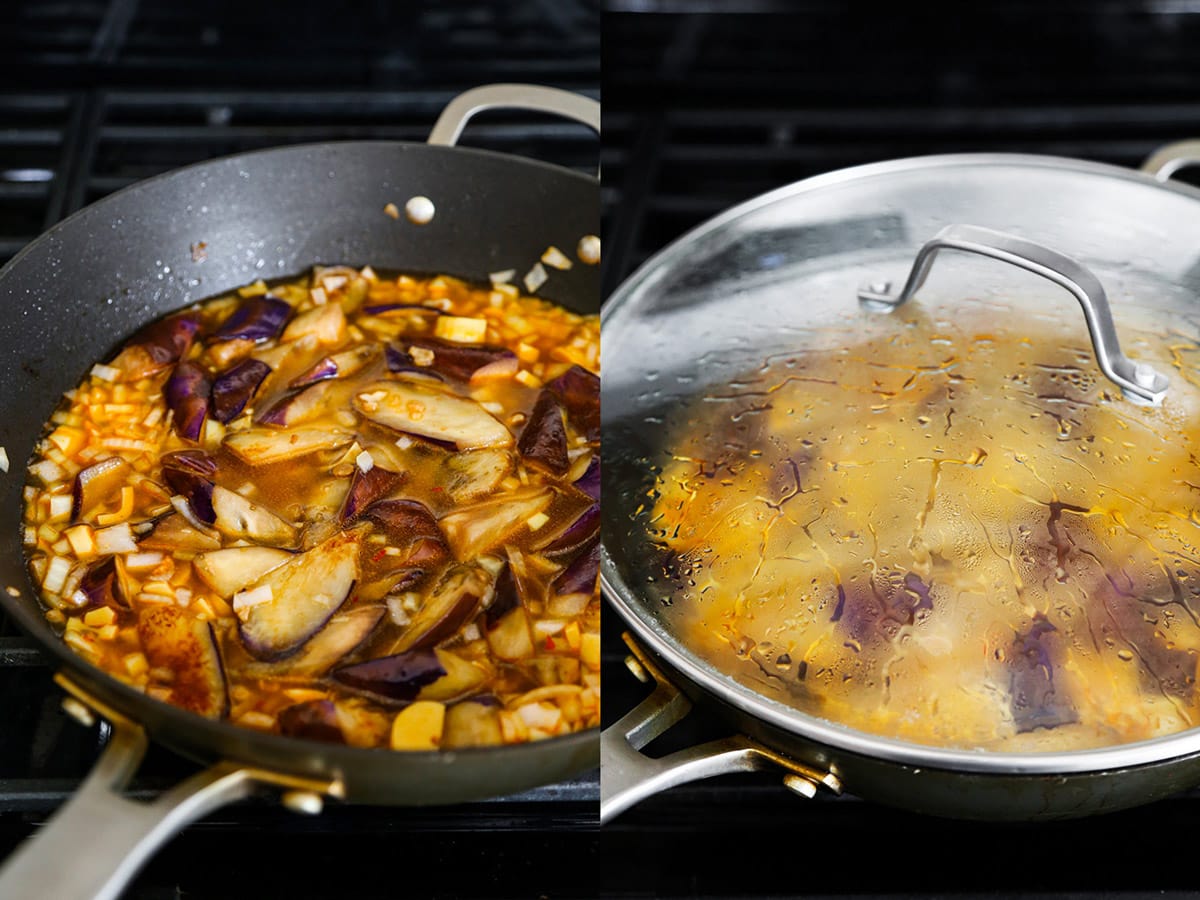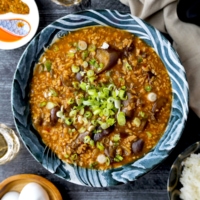This is a vegetarian recipe for Japanese mabo nasu which is a cross between Yú Xiāng (鱼香茄子), or fish fry eggplant, and mapo tofu . The eggplant is tossed in a gooey savory, earthy, and nutty sauce, perfect for pouring over rice. It’s delicious!

What is Mabo Nasu?
Mabo nasu is a popular Japanese dish consisting of sliced eggplant and ground pork that are cooked in a savory and pungent gooey sauce made with tobanjan, soy sauce, oyster sauce, sugar, stock, and potato starch. It is the same as mabo tofu except that eggplant, which is “nasu” in Japanese, is used instead of tofu. The dish is meant to be enjoyed with a side of Japanese rice.
Mabo nasu is one of many Japanese dishes that was influenced by Chinese cuisine and adapted to suit the Japanese palate. Japanese people are very sensitive to spicy foods which is why you will rarely find red chili peppers added to dishes.

Ingredients for Mabo Nasu
Scroll all the way down for the full recipe.
- TVP: Tvp stands for “textured vegetable protein.” It is a processed textured soy protein that’s both high in fiber and protein. It’s often used as an alternative to meat because of its meat-like texture, and also because it absorbs flavor easily. For this recipe I used crumbles to mimic ground pork.
- Bamboo shoots: When I originally made this mabo nasu, I only used tvp. It was good but I felt it needed something extra. By adding chopped bamboo it made the dish more interesting texture wise and lightened it up at the same time.
- Eggplant: Regular eggplant won’t work for this recipe since it contains too many seeds. You will need Chinese or Japanese eggplant, which are long and thin. You can easily find them at your local Asian grocery store or sometimes at Whole Foods.
- Oil: Use a neutral oil such as vegetable or grapeseed oil to fry the eggplant.
- Tobanjan (doubanjiang): Tobanjan is a Chinese bean paste made from fermented beans, salt, chili peppers, soybeans, and flour. It’s very pungent and salty so you will only need a little for this recipe.
- Shaoxing wine: Shaoxing wine is an essential ingredient in Chinese cooking. It has a unique taste that’s a little sweet like caramel, slightly boozy, and vinegary. Dry sherry can be used as an alternative.
- Sugar: A little sugar is used to mellow and balance the saltiness of the dish.
- Soy sauce: Soy sauce is what adds umami to many Asian dishes, including this mabo nasu. If you are vegan, omit it and use soy sauce.
- Oyster sauce: Think of oyster sauce as a more complex version of soy sauce. It has everything in terms of flavor – it’s sweet, salty, umami, pungent, slightly briny, and earthy.
- Garlic: Two cloves of garlic, minced, is used to flavor the oil with sweetness and earthiness.
- Stock: Use low sodium chicken stock or vegetable stock to make the dish vegan.
- Onion: Normally, onions are added at the beginning of a recipe to bring fragrance to a dish, but we are adding them closer to the end for this one, so they can infuse plenty of amami, the Japanese word for sweetness.
- Potato starch: Potato starch is used to thicken the sauce and give it that classic gooeyness we love so much about Asian food. Alternatively, you can also use cornstarch.
- Salt: Just a pinch to balance out the flavors.
- Rice vinegar: One teaspoon is just enough to add a touch of sourness.
- Sesame oil: Used as a finishing oil to dress the dish with a little nuttiness.
- Scallions: The chopped scallions add a pop of color and a lovely refreshing crunch!

How to Make Mabo Nasu
- Gather all of your kitchen tools and ingredients.
- Add the tvp in a bowl and pour 1/4 cup of hot water over it. Give it a quick stir and leave for about 10 minutes, until the tvp is rehydrated.
- Slice the eggplant and soak it in a bowl of water for 15 minutes. This will get rid of some of the bitterness. Drain the eggplant and pat the pieces dry with a paper towel or kitchen towel.
- Add the eggplant to a large deep skillet (a wok also works) and turn the heat to medium. Cook the eggplant for 1 minute and drizzle 2 tablespoons of neutral oil over the pieces. Toss the eggplant until all the pieces are coated evenly and cook for 4 minutes.
- Drizzle one more tablespoon over the eggplant pieces and toss to coat evenly. Cook for 3 minutes.
- Transfer the eggplant to a bowl or a plate but do not turn the heat off. The texture of the eggplant should be tender but still a little crunchy.
- Add the remaining tablespoon of oil to the same skillet and stir in the tvp and chopped bamboo. Cook for 3 minutes, or until the tvp is golden.
- One by one, add the tobanjan, shaoxing wine, sugar, soy sauce, oyster sauce, and garlic, and cook for 30 seconds.
- Stir in the chicken stock and chopped onion, and return the eggplant to the deep skillet.
- Bring to a boil, lower the heat to a bubbling simmer, cover, and cook for 6 minutes.
- Add the potato starch and water mixture to the skillet while continuously stirring. Keep stirring until the sauce thickens (about 30 seconds) and add the salt and rice vinegar.
- Turn the heat off and add the sesame oil.
- Serve the mabo tofu with rice and top with chopped scallions.

Can I Freeze Mabo Nasu?
You can technically freeze mabo nasu but I would advise against it because the texture of the eggplant might get very moussy.
Cooking with eggplant is such a finicky business. It’s one of those vegetables that require more attention to details than something easy like a cucumber. If the cooking time is too short, the eggplant will have rubbery texture (that no one likes!) and will automatically ruin a dish. If it’s cooked for too long, it will get mushy and fall apart.
I find that the more you mess with it, the worse the texture becomes which is why I don’t recommend freezing, thawing, and reheating eggplant.

What to Serve with Mabo Nasu
The best way to enjoy mabo nasu is with a side of Japanese white rice. The sticky fat grains absorb the sauce beautifully and instantly elevate the dish. However, if you prefer brown rice, please go ahead and enjoy the dish with that.
This Japanese eggplant stir fry is quite filling so if you are planning to serve other dishes with it, I recommend small sides that are light or refreshing, such as:
- Hijiki seaweed salad
- Japanese cucumber salad (sunomono)
- Green salad with carrot ginger dressing
- Edamame with soy and sesame sauce
- Stir fry veggies
Some of my favorite eggplant recipes: Nasu dengaku, Japanese eggplant tartare, Chinese eggplant with garlic sauce, steamed Korean eggplant, eggplant miso soup, Chinese style eggplant with sesame sauce, Szechuan style nasu dengaku, char siu style roasted eggplant.

Did you like this recipe? Are there changes you made that you would like to share? Share your tips and recommendations in the comments section below!
Print
Mabo Nasu (Japanese Style Eggplant Stir Fry)
- Prep Time: 15 minutes
- Cook Time: 20 minutes
- Total Time: 35 minutes
- Yield: 4 1x
- Category: Main
- Method: Stir frying
- Cuisine: Japanese
- Diet: Vegetarian
Description
This is a vegetarian recipe for Japanese mabo nasu. The eggplant is tossed in a gooey savory, earthy, and nutty sauce, perfect for pouring over rice. It’s delicious!
Ingredients
- 1 oz TVP (textured vegetable protein), should equal about 1/4 pound, rehydrated
- 4 oz bamboo shoots, chopped
- 2 medium size Japanese or Chinese eggplant (about 1 pound), sliced rangiri style or about 1-inch thick
- 4 tablespoons vegetable oil
- 1 tablespoon tobanjan (doubanjiang)
- 1 tablespoon shaoxing wine, or dry sherry
- 2 teaspoons sugar
- 2 tablespoons soy sauce
- 1 tablespoon oyster sauce (for vegan: omit oyster sauce and add an additional tablespoon soy sauce instead)
- 2 garlic cloves, minced
- 2 1/4 cups low sodium chicken stock (for vegan: use mushroom broth or low sodium vegetable broth)
- 1 small onion, finely chopped
- 1 1/2 tablespoon potato starch or cornstarch mixed with 3 tablespoons water
- 1/2 teaspoon kosher salt
- 1 teaspoon plain rice vinegar
- 1/2 teaspoon sesame oil
- 3 scallions, finely chopped (optional)
Instructions
- Put the TVP in a bowl and add ¼ cup boiling hot water. Let the TVP rehydrate for about 10 minutes.
- Soak the eggplant in a bowl of water for 15 minutes. Drain and pat dry.
- Place the sliced eggplant in a large deep skillet and turn the heat to medium. Toss the eggplant for 1 minute and drizzle 2 tablespoons of the vegetable oil.
- Toss the eggplant until all the pieces are evenly coated with the oil and cook the eggplant for 4 minutes, stirring occasionally.
- Add 1 tablespoon of oil by drizzling it over the eggplant and cook for 3 minutes. The eggplant should be slightly tender but not cooked enough so it’s ready to eat yet.
- Transfer the eggplant to a plate and set aside. Do not turn the heat off.
- Use the same skillet and add the TVP and bamboo with the remaining 1 tablespoon oil. Cook for 3 minutes while stirring constantly, until the TVP is golden.
- Stir in the tobanjan, shaoxing wine, sugar, soy sauce, oyster sauce, and garlic and cook for 30 seconds. Keep stirring until the ingredients are well combined.
- Add the chicken stock, onion, cooked eggplant, and stir.
- Bring to a boil and lower the heat to low (bubbling simmer). Cover and cook for 6 minutes.
- Stir the potato starch and water mixture and slowly add it to the pan, stirring constantly. Cook for 30 seconds, or until the sauce thickens and stir in the salt and rice vinegar.
- Turn the heat off, stir in the sesame oil, and transfer the mapo eggplant to a serving bowl. Top with scallions and serve with Japanese rice.
Notes
Keep the leftover mabo nasu in an airtight storage container. It will keep in the fridge for up to 3 days.
Nutrition
- Serving Size: 1 bowl
- Calories: 249
- Sugar: 10.5g
- Sodium: 635.6mg
- Fat: 15.3g
- Saturated Fat: 11.5g
- Unsaturated Fat: 0.8g
- Carbohydrates: 23.1g
- Fiber: 5.7g
- Protein: 8.8g
- Cholesterol: 0mg















We grow vegetables and this year we have an abundance of eggplant. I made this last night and my husband and I loved it. I will make it again.
Thank you so much Carmen! 🙂
Another great recipe! I used crushed soy curls instead of TVP and water chestnuts instead of bamboo shoots but this was so tasty! Thank you!!
That’s great Sarah! Chestnuts are a great idea to add a nice crunch to this dish! Thank you for sharing 🙂